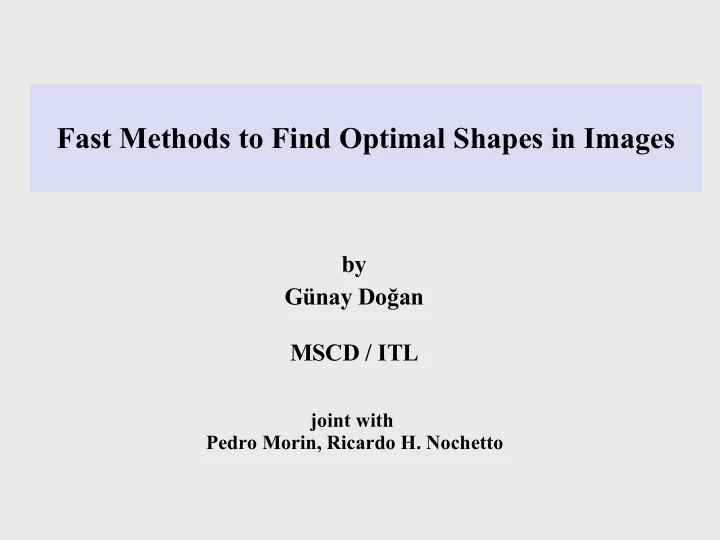

Fast Methods to Find Optimal Shapes in Images by Günay Doğan MSCD / ITL joint with Pedro Morin, Ricardo H. Nochetto
Image Segmentation Goal: To capture objects & boundaries in given 2d / 3d images
Image Segmentation Goal: To capture objects & boundaries in given 2d / 3d images
Segmentation Related • Medical imaging • Motion detection & tracking • 3d scene reconstruction • Image understanding • Scientific visualization • Surgery planning … … …
Finding the Right Curves Q: How do we decide which are the right curves?
Shape Optimization Approach Define shape energy for given shape Compute a sequence ... such that
Differential Geometry boundary domain outer unit normal
Differential Geometry For smooth extended to a neighborhood of (normal derivative) (tangential gradient) (tangential divergence) (Laplace-Beltrami)
Finding the Right Curves Q: What are the right energies to impose on curves?
Shape Energies for Segmentation Kass, Witkin, Terzopoulos, 88 Fue, Leclerc, 90 Caselles, Kimmel, Sapiro, 95 Caselles, Kimmel, Sapiro, Sbert, 97 Paragios, Deriche, 00 Chan, Vese, 01 Tsai, Yezzi, Willsky, 01 Aubert, Barlaud, Faugeras, Jehan-Besson, 03 Kimmel, Bruckstein, 03 Desolneaux, Moisan, Morel, 03 Hintermueller, Ring, 03 and many more ...
Edge Indicator Function Edge indicator function: I H edge edge edge 1 x x x
Edge Indicator Function I(x) H(x)
Geodesic Active Contours Generic form of geodesic active contour / surface energy Minimize weighted area of surface and enclosed volume. 2 nd term helps with concavities, brings extra push. ( Caselles et al., 95; Caselles et al. 97)
Geodesic Active Contours Computing large small (local min)
The Mumford-Shah Model Given I(x) , find discontinuities K and p.w. smooth approx. u
The Mumford-Shah Model Given I(x) , find discontinuities K and p.w. smooth approx. u Not practical in this form. Two approaches: • Ambrosio-Tortorelli approach: modified functional with diffuse discontinuities • Chan-Vese approach: restrict K to closed curves, use curve evolution
Chan-Vese Approach optimality cond. w.r.t (Chan & Vese, 01; Tsai, Yezzi & Willsky, 01)
Shape Derivatives Shape derivative of J ( ) in direction V :
Shape Derivatives Shape derivative of J ( ) in direction V : Second shape derivative w.r.t. V, W :
Shape Gradient The structure of the shape derivative for J ( ) where G is the shape gradient. For most cases
Shape Gradient The structure of the shape derivative for J ( ) where G is the shape gradient. For most cases Choose
Geodesic Active Contours First shape derivative with
Geodesic Active Contours First shape derivative with Energy-decreasing velocity
Geodesic Active Contours Behavior of
Geodesic Active Contours Behavior of H I edge edge 1 edge 0 x x x
Example: Bacteria Image
Other Descent Directions Take a scalar product on • continuous • coercive And solve The solution V satisfies
Other Descent Directions Instead of the velocity eqn Use the more general velocity eqn with the scalar product For example, use weighted scalar product The general velocity eqn is
Geodesic Active Contours Second shape derivative with (Hintermueller & Ring, 03)
Bacteria: H 1 Flow H 1 flow 276 iters vs L 2 flow 865 iters
Finite Element Method on Surfaces Solve on surface
Finite Element Method on Surfaces Solve on surface Weak form
Finite Element Method on Surfaces Solve on surface Weak form Substitute
Finite Element Method on Surfaces Solve on surface Weak form Substitute Linear system
Computing the Velocity At each iteration solve the following to get Obtain the new curve/surface
Computing the Velocity At each iteration solve the following to get Obtain the new curve/surface
Computing the Velocity At each iteration solve the following to get Obtain the new curve/surface
Computing the Velocity At each iteration solve the following to get System of PDEs Obtain the new curve/surface
Computing the Velocity At each iteration solve the following to get System of PDEs Weak form Obtain the new curve/surface
Linear System At each iteration solve the following to get Weak form Linear system Obtain the new curve/surface
Other Descent Directions Instead of the velocity eqn Use the more general velocity eqn with the bilinear form For example, use 2 nd shape deriv. for Newton’s method
Practical Issues: Step Size How to choose the right step in • too small → too many iterations • too large → may miss the objects Soln: perform backtracking or line search
Practical Issues: Topological Changes Four step procedure for topological changes in 2D – detect element intersections – adjust intersection locations – reconnect elements – clean up artifacts before detect adjust reconnect
Example: Medical Image
Practical Issues: Resolution How to choose the right number of elements? • too many elements → too many computations • too few elements → may miss the objects Soln: employ space adaptivity to adjust resolution adapt to adapt to image geometry
3d Example: Touching Balls
3d Example: Prism
Mumford-Shah Energy subject to First shape derivative where jump of f across
Mumford-Shah Energy Second shape derivative with (Hintermueller & Ring, 03)
Mumford-Shah Energy Velocity equation Two choices of scalar products • L 2 flow: • H 1 flow:
Bacteria: H 1 Flow
Bacteria: L 2 Flow vs H 1 Flow L 2 flow H 1 flow 586 iters, 2m 51s 142 iters, 43s
Bacteria: Pw. Smooth Approximations
Bacteria: Pw. Smooth Approximation
Domain Meshes
Simultaneous Segmentation & Denoising 107 iters, 47s
Galaxy: No Edges 53 iters, 20s
Summary • Introduced shape optimization for image segmentation • Started with shape sensitivity analysis, i.e. shape derivatives • Implemented discrete gradient flows with finite elements • Implemented computational enhancements for robustness • Applications: Geodesic Active Contours, Mumford-Shah Model
Recommend
More recommend